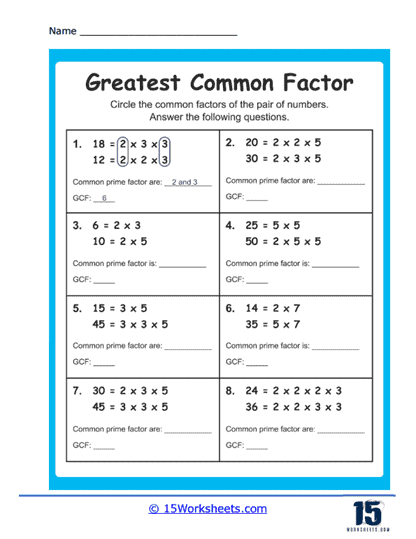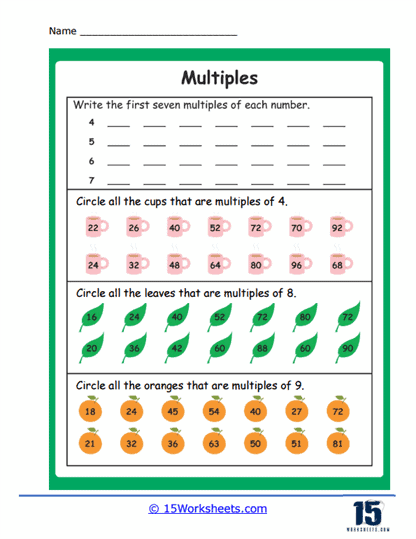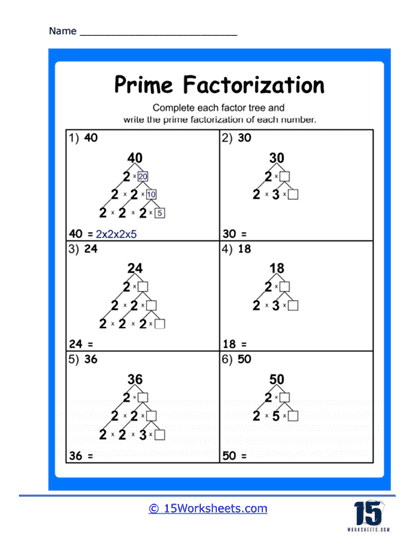Factors Worksheets
About These Worksheets
These worksheets contain exercises and problems that require students to construct factor trees for given numbers, break them down into their prime factors, and perform related calculations. Factor tree worksheets teach students how to break down composite numbers (numbers that can be divided evenly by more than just 1 and themselves) into their prime factors.
These worksheets contain a series of exercises and problems that require students to determine the largest number that evenly divides multiple given numbers Finding the greatest common factor is fundamental for simplifying calculations, understanding the relationship between numbers, and solving a wide range of mathematical problems.
These worksheets contain a series of exercises and problems that require students to determine the smallest number that is a multiple of multiple given numbers. They teach students how to find the least common multiple of two or more numbers.
This set of worksheets will help students practice and develop their skills in identifying and listing all the factors of a given number. This knowledge is useful for a wide range of applications, including simplifying fractions, finding common factors and multiples, and solving various mathematical problems.
These worksheets will provide you with a great deal of practice and develop your skills in identifying and working with multiples of numbers. Knowledge of multiples is essential in various areas of mathematics, including factors, divisibility, and prime factorization.
These worksheets will help students practice and develop their skills in breaking down composite numbers into their prime factors. Students learn to identify prime numbers, which are numbers that have exactly two distinct positive divisors (1 and themselves).
What Are Factors?
Factors are numbers that divide another number completely, leaving no remainder. In simpler terms, if you can multiply two numbers to get another number, those two numbers are factors of the larger number. For instance, for the number 12, 1, 2, 3, 4, 6, and 12 are all factors since they can multiply in pairs to produce 12. To help young explorers like you understand and practice this concept we have created this series of worksheets.
The world of factors is like a puzzle. Each number has its set of factors, and these factors give insight into the characteristics of that number. For example, knowing the factors of a number can tell us if it’s even or odd, large or small, or even if it’s a prime number (numbers that only have 1 and themselves as factors). This makes factors foundational in the realm of mathematics.
Now, when you dive into these factors worksheets, you’ll find a treasure trove of exercises tailored to deepen your understanding. A very basic exercise might simply provide a number, like 15, and ask you to list all its factors. By doing this, you practice the core idea of factors and familiarize yourself with the fundamental pairs of numbers that multiply to give your main number.
Some sheets might showcase two numbers side by side, asking you to identify the common factors between them. This requires you to list out factors for both numbers and then find the numbers that appear in both lists. It’s like a mathematical scavenger hunt!
Some worksheets will also incorporate fun challenges, like factor mazes or factor crosswords. These exercises blend the joy of games with the concept of factors, making the learning process all the more engaging.
These worksheets serve as a ladder, allowing you to climb the heights of understanding one step at a time. Each exercise solidifies your grasp on factors, making you more confident in handling numbers. The process of finding factors enhances your analytical thinking, attention to detail, and systematic problem-solving approach. These skills are not just relevant for now, but they’re instrumental as you progress to more complex mathematical concepts in the future. As you embark on topics like fractions, algebra, and even geometry, this foundational understanding of factors will be a guiding light.
Yet, beyond the school walls, you might ponder, “Where do factors come into play in daily life?” Factors, surprisingly, are intertwined with many everyday situations.
Imagine you’re organizing a party and you have a box of chocolates to share equally among your friends. Knowing the factors of the total number of chocolates helps you figure out how many friends you can share with, ensuring everyone gets an equal amount.
In the realm of sports, especially team games, understanding factors can be essential. If you’re setting up teams with an equal number of players, knowing the factors of the total number of players available can help you decide how many teams you can form.
For those who enjoy arts and crafts, factors play a role too! Suppose you have a certain number of beads and you wish to create bracelets with an equal number of beads in each. Recognizing the factors of the total beads will guide you in determining how many beads each bracelet will contain.
Even in daily chores, such as arranging books on a shelf or packing items in boxes, the concept of factors sneaks in. It ensures you utilize resources optimally, with minimal wastage.






